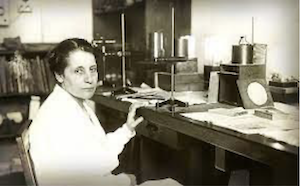
Lise Meitner was born on November 7, 1878, in Vienna to an upper-class Jewish household. Her father was among one of the first Jewish lawyers to practice in Vienna and was also a well-known chess player. In 1905, she became one of the first women to obtain a Doctorate in Physics at the University of Vienna. After she earned her degree, she went to Berlin to find research opportunities because of the lack of career prospects for women. There, she met Max Planck, a professor at Friedrich Wilhelm University who taught physics and rarely admitted women into his lab but viewed Meitner as an exception.
Otto Hahn, who she would end up collaborating with for 30 years, worked in the chemistry lab at Friedrich Wilhelm University. Since women were not allowed to be admitted into universities in Prussia, Meitner had to be accommodated by men and couldn’t enter most facilities at the university, including the restrooms and Hahn’s office. However, a year later, women were allowed to attend universities in Prussia, and Meitner could freely work there. Hahn and Meitner first found radioactive recoil before discovering new isotopes. Both chemists moved to the Kaiser Wilhelm Institute, where she became the first woman to become a full-time professor for physics in Germany.
During World War II, Meitner ended up fleeing Berlin after the Anchlhss, where Germany was unified with Austria. She lost her Austrian citizenship because of the war and due to her Jewish heritage, she was no longer safe in Germany. Eventually, she was able to reconnect with her colleagues including Hahn. Hahn had been working with German chemist Fritz Strassman who was researching isotopes. Meitner and another chemist discovered a process that splits the Uranium nucleus into two, which they classified as fission. Meitner told Hahn that the nucleus of Uranium could dissolve and encouraged Hahn and Strassman to test the Radium more extensively and because of her efforts it led to the discovery of nuclear fission.

Meitner was nominated 49 times for a Nobel Peace Prize (30 times in Physics and 19 times for Chemistry) but never won. In 1945, Hahn was granted the Nobel Peace Prize in Chemistry for the discovery of nuclear fission. While both Meitner and Hahn discovered it, the award was not given to Meitner and Hahn did not mention her efforts in his speech. She did win other awards including the Enrico Fermi Award in 1966 and the German Physical Society’s Max Planck Medal in 1949.
The discovery of nuclear fission led to the creation of the atomic bomb. Therefore, she was given the nickname ‘Mother of the Atomic Bomb’. However, Meitner made it clear that she disapproved of the name and the use of her discovery to create a weapon of mass destruction. After the bombing of Hiroshima, Meitner became more known all over the world for her discovery of nuclear fission. She caught the attention of First Lady Eleanor Roosevelt and had the opportunity to interview with her, and she had dinner with President Truman years later. She also met with Albert Einstein to discuss Physics, and he would later refer to her as the “German Marie Curie”.
Meitner continued to teach physics at Ivy League universities: Princeton, Columbia, and Harvard. She was granted honorary doctorates from Smith College, University of Rochester, Rutgers University, and the University of Stockholm. She co-founded an isotope of Protactinium: element 109 and was named after it, making her one of the few women whose name was used for an element. On October 27,1964, she suffered a heart attack and died in Cambridge, United Kingdom. In 2010, the Otto Hahn Building for Chemistry at the Free University of Berlin was renamed the Hahn-Meitner Building. The University of Vienna displays a bust of Meitner and a statue of her is at the Humboldt University of Berlin. The International Atomic Energy Agency established the Lise Meitner program to help further develop the careers of women in nuclear energy. Meitner’s legacy demonstrates how important her contributions were to the nuclear and physics field.
Why Did I Choose to Research Lise Meitner?
I decided to research Lise Meitner because I had come across an article of Christopher Nolan’s “Oppenheimer” when it was still in production. The part that stood out to me was that one of Oppenheimer’s colleagues told him that Hahn and Strassman split the atom. I was intrigued because I had done my research beforehand and was perplexed on why they didn’t mention Meitner. In fact, many other sources failed to mention her at all. This prompted me to write this article because I want her to be recognized for her accomplishments.
Works Cited
“December 1938: Lise Meitner & Otto Frisch Discover Nuclear Fission.” American Physical Society, https://www.aps.org/publications/apsnews/200712/physicshistory.cfm
“Lise Meitner.” Physics Today, American Institute of Physics, 27 Apr. 2017, https://physicstoday.scitation.org/do/10.1063/pt.6.6.20171107a/full/
“Lise Meitner (1878 - 1968).” Lise Meitner | Biographies, https://www.atomicarchive.com/resources/biographies/meitner.html
Rife, Patricia. “Lise Meitner.” Jewish Women's Archive, https://jwa.org/encyclopedia/article/meitner-lise
This article was published on 2/28/24